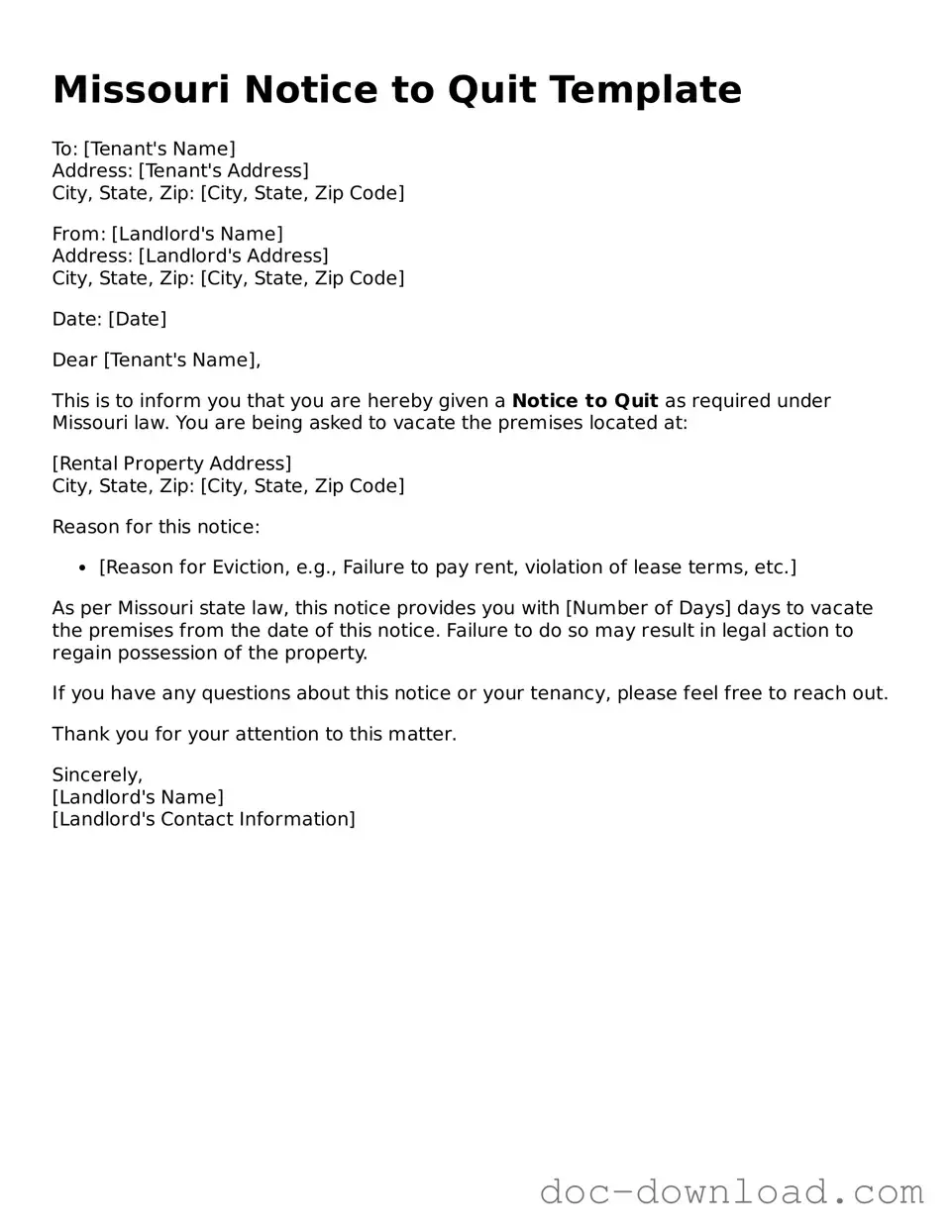The Missouri Notice to Quit form serves as a formal notification to tenants that they must vacate the rental property. Similar to this document is the Eviction Notice, which landlords use to inform tenants of their intention to terminate the lease due to violations of rental agreements or non-payment of rent. Both documents outline the reasons for termination and provide a timeline for the tenant to vacate the premises. The Eviction Notice may include specific legal references, while the Notice to Quit generally provides a straightforward request for the tenant to leave.
Another document akin to the Missouri Notice to Quit is the Lease Termination Letter. This letter is typically used by landlords or tenants to officially end a lease agreement, often in accordance with the lease's terms. While the Notice to Quit demands immediate action due to specific breaches, the Lease Termination Letter may simply notify the other party of the intent to end the lease at the conclusion of the lease term, allowing for a more amicable resolution.
The importance of understanding various real estate documents cannot be overstated, especially when engaging in property transactions. For those dealing with agreements in Colorado, familiarizing oneself with the Colorado Real Estate Purchase Agreement is essential. This form is instrumental in defining the specifics of the sale and ensuring compliance with state laws. To enhance your understanding and access essential documents, including the Real Estate Purchase Agreement, you might explore resources like Colorado PDF Forms.
The Demand for Rent is also similar in nature. This document is issued when a tenant has failed to pay rent on time. It serves as a reminder and a formal request for payment before further legal actions, such as eviction, are pursued. Like the Notice to Quit, it emphasizes the necessity for the tenant to take action, though it specifically addresses overdue rent rather than lease termination.
A Notice of Default shares similarities with the Notice to Quit, particularly in its purpose of informing a party of a breach of contract. Typically used in mortgage agreements, this document notifies the borrower of missed payments and the potential consequences. Both documents aim to prompt action from the recipient, although the Notice of Default is more focused on financial obligations, while the Notice to Quit addresses tenancy issues.
The 14-Day Notice to Vacate is another document that resembles the Missouri Notice to Quit. This notice is often used in various states to provide tenants with a specific timeframe to leave the property, typically for lease violations. Both documents convey urgency and outline the necessity for the tenant to vacate, though the 14-Day Notice to Vacate may be more standardized in its timeframe and application.
A Notice of Lease Violation is similar in that it addresses issues concerning the tenant's behavior or actions that violate the lease agreement. This document serves as a warning and can precede a Notice to Quit if the issues are not resolved. While the Notice of Lease Violation focuses on specific breaches, the Notice to Quit is a broader request for the tenant to leave the property altogether.
The Rent Demand Letter is another comparable document. This letter requests payment for overdue rent and may serve as a precursor to more severe actions, such as eviction. Both documents are designed to prompt the tenant to take corrective action, although the Rent Demand Letter specifically addresses financial obligations, while the Notice to Quit addresses the tenant's overall status in relation to the lease.
Finally, the Notice of Intent to Vacate can be seen as similar in that it is used by tenants to inform landlords of their decision to leave the rental property. This document outlines the tenant's intent and provides a timeline for departure. While the Notice to Quit is initiated by the landlord, both documents facilitate communication regarding tenancy and the end of the rental agreement.
